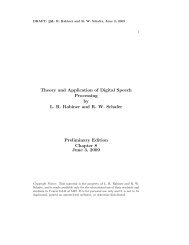Theory and Application of Digital Speech Processing by L. R. ...
Theory and Application of Digital Speech Processing by L. R. ...
Theory and Application of Digital Speech Processing by L. R. ...
You also want an ePaper? Increase the reach of your titles
YUMPU automatically turns print PDFs into web optimized ePapers that Google loves.
DRAFT: L. R. Rabiner <strong>and</strong> R. W. Schafer, June 3, 2009<br />
6 CHAPTER 1. INTRODUCTION TO DIGITAL SPEECH PROCESSING<br />
a spectral representation (Fourier magnitudes <strong>and</strong> phases),<br />
a homomorphic representation (the so-called cepstral domain), <strong>and</strong> finally<br />
a modeling domain such as linear predictive coding (LPC).<br />
It will be shown, throughout this book, that each <strong>of</strong> these representations<br />
has various strengths <strong>and</strong> weaknesses <strong>and</strong>, as such, all are used widely <strong>and</strong><br />
extensively in modern speech processing systems.<br />
The third layer in the stack is the one that converts the various speech<br />
representations into algorithms that estimate important properties <strong>of</strong> the speech<br />
signal; e.g. whether a section <strong>of</strong> the signal waveform should be classified as:<br />
speech or silence (background signal),<br />
voiced speech or unvoiced speech or background signal<br />
If the section <strong>of</strong> speech is classified as voiced speech, various speech algorithms<br />
(known collectively as pitch detection methods) facilitate the determination <strong>of</strong><br />
the pitch period (or pitch frequency), <strong>and</strong> a different set <strong>of</strong> algorithms (known<br />
collectively as formant estimation methods) can be used to estimate the set <strong>of</strong><br />
vocal tract resonances or formants for all speech sounds.<br />
The fourth <strong>and</strong> top layer in the stack is the set <strong>of</strong> end-user applications <strong>of</strong><br />
speech processing. This layer represents the pay<strong>of</strong>f for the technology <strong>and</strong> consists<br />
<strong>of</strong> a range <strong>of</strong> applications including speech coding, speech synthesis, speech<br />
recognition <strong>and</strong> underst<strong>and</strong>ing, speaker verification <strong>and</strong> recognition, language<br />
translation, speech enhancement systems, speech speed-up <strong>and</strong> slow-down systems,<br />
etc. In the following sections we give an overview <strong>of</strong> several <strong>of</strong> these<br />
application areas, <strong>and</strong> in the later chapters <strong>of</strong> this book we give detailed descriptions<br />
<strong>of</strong> the main three application areas, namely speech <strong>and</strong> audio coding,<br />
speech synthesis <strong>and</strong> speech recognition <strong>and</strong> natural language underst<strong>and</strong>ing.<br />
1.4 Organization <strong>of</strong> the Book<br />
The organization <strong>of</strong> this book closely follows the layers in the speech stack.<br />
We begin, in Chapter 2, with a review <strong>of</strong> the most important digital signal<br />
processing concepts that are utilized throughout this book for the various speech<br />
representations <strong>and</strong> measurements. We place special emphasis on three topics,<br />
namely:<br />
1. conversion from the time domain to the frequency domain (via discrete<br />
Fourier transform methods),<br />
2. underst<strong>and</strong>ing the impact <strong>of</strong> sampling in the frequency domain (i.e., aliasing<br />
in the time domain), <strong>and</strong><br />
3. underst<strong>and</strong>ing the impact <strong>of</strong> sampling (both down <strong>and</strong> up sampling) in<br />
the time domain, <strong>and</strong> the resulting aliasing or imaging in the frequency<br />
domain.

















